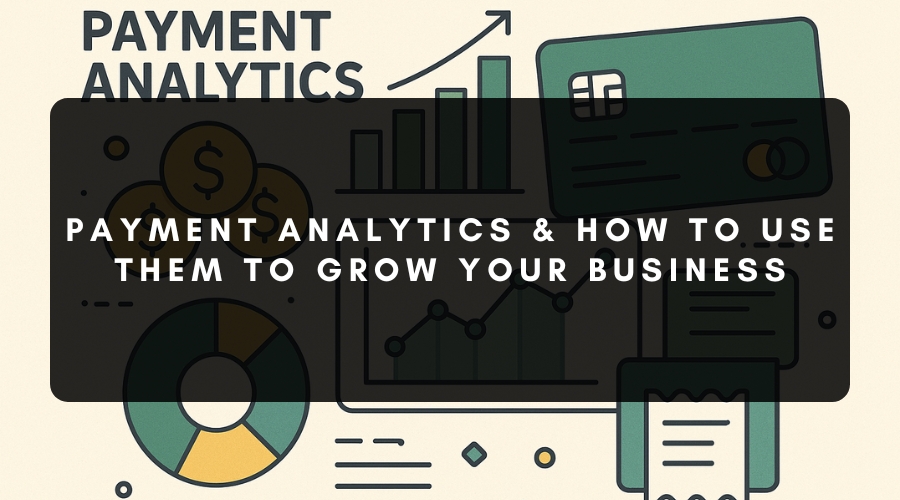
Payment Analytics & How to Use Them to Grow Your Business
Payment analytics have become a vital tool for astute, data-driven enterprises in the fast-paced European business world. Tracking and evaluating transaction activity is becoming crucial for business owners who want to maximise efficiency, improve customer satisfaction, and spur revenue growth.
The first step is understanding the concept of payment analytics and implementing this tool in your business. The second is learning how to use them to optimise your company’s operations and financial results.
What Are Payment Analytics?
“Payment analytics” refers to the gathering, processing, and analysis of transaction data across channels and payment methods. Payment analytics are often included with merchant services packages. They give you real-time visibility into all payment activity, including:
- Transaction volumes and amounts
- Failed transactions
- Authorisation rates
- Chargeback rates
- Popular payment types
- Customer purchase behaviour and cart abandonment
Businesses can use this data to produce actionable insights for improved decision-making in areas like customer engagement, operational efficiency, risk management, and fraud prevention.
Benefits of Payment Analytics
Payment analytics are a crucial tool for informed decision-making in an era where data must support every business decision. They help you:
- Increase conversion rates
- Lower expenses
- Optimise working capital
- Improve customer experience
- Reduce fraud
- Boost revenue growth by knowing how, when, and where your customers make payments
How to Use Payment Analytics to Grow Your Business
Use these strategies to enhance your business with payment analytics.
1. Improve Business Decision Making With Key Metrics
Quickly gain insight into the state of your payment system by examining important metrics like the following:
- Authorisation rate: Your authorisation rate refers to the percentage of attempted transactions that are successfully authorised.
- Failed transaction rate: These missed opportunities are frequently caused by inadequate funds, expired cards, or an outdated payment system.
- Chargeback rate: A high chargeback rate can harm your reputation by indicating fraud or customer dissatisfaction. It is essential for businesses to monitor and reduce chargebacks.
- Conversion rate: Your conversion rate indicates the proportion of users who actually finish paying after adding items to their carts.
- Average transaction amount: This metric helps you identify potential pricing problems and upsell opportunities.
- Payment type usage: Improve the checkout experience by understanding which payment methods your customers prefer, such as credit cards, Apple Pay, SEPA Direct Debit, etc.
- Transaction frequency by channel: Track various channels (online, mobile, and point of sale) to gain insight into customer preferences.
2. Understand Customer Behaviour
Trends in transaction activity show you how customers behave across various channels, including online, mobile, and in-store. Preferred payment methods, typical transaction values, and peak sales times are a few examples of this.
You can use analytics and machine learning tools to segment your customer base according to their behaviour and provide customised promotions or flexible payment plans that increase sales and decrease cart abandonment.
For example, a German retailer might find that younger customers abandon their carts during the checkout process when Apple Pay isn’t an option. They may then decide to add Apple Pay to boost their conversion rates with this demographic.
3. Enhance Fraud Prevention and Monitoring
Payment analytics are crucial in order to prevent and monitor fraud. Your system can identify suspicious activity in real time by monitoring irregularities in transaction types, unusual transaction amounts, or inconsistent customer locations.
Machine learning-enabled advanced analytics tools can identify fraudulent activity patterns that human teams might overlook. This makes it possible to act quickly, minimising monetary losses and reputational harm.
4. Optimise Payment Operations Across Multiple Locations
Real-time visibility into business operations is crucial for European companies with multiple locations, whether they have physical stores or operate online. Your transaction data is consolidated into a single dashboard with payment analytics. This streamlines:
- Payment system configurations
- Market-wide risk management
- Staff training based on typical customer issues
- Inventory scheduling according to periods of high transaction volume
Decision-makers can standardise effective procedures across all sites with centralised reports, increasing operational effectiveness and promoting consistent revenue growth.
For example, let’s imagine a payment platform is used by a retail chain with locations in France, Germany, and Spain, and tracks all transaction data in real time. The company could determine from a single dashboard that a local payment method issue is the reason behind the higher number of unsuccessful payments in Germany. Based on this insight, they can swiftly resolve the payment issue, have employees reach out to customers to recover the lost sales, and boost their revenue.
5. Reduce Costs and Improve Resource Allocation
Ineffective payment methods frequently result in significant expenses, like higher chargeback rates, additional bank fees, or labour-intensive manual reconciliation. You can identify inefficient parts of your company’s operations and redirect funds to more lucrative ones with the help of the appropriate analytics tools.
A company in Italy might find that credit card payments made through a legacy processor have a lower authorisation rate and higher fees than mobile payment methods. They will then be able to improve their margins immediately by changing processors or renegotiating fees.
6. Comply With Payment and Data Laws
Strict data and payment laws, like GDPR (General Data Protection Regulation) and PSD2 (Payment Service Directive 2), regulate the European markets. The GDPR requires records of processing activities that can be provided to authorities on request, including details about data categories, data subjects, data recipients, and the purpose of processing. Payment analytics helps with compliance and increases customer trust by providing auditable records of transaction activity.
7. Support Cross-Border Expansion
Payment analytics smooth the path for cross-border expansion within Europe’s single market. You can monitor fraudulent activity in unknown regions, measure currency conversion rates, track performance by country, and adjust payment types to local preferences. Payment analytics also help you better understand local client needs, whether you’re expanding from Poland to the Netherlands or from Spain to Germany.
8. Boost Business Performance With Actionable Reports
The capacity of payment analytics to transform complicated data into useful insights is its greatest advantage. Numerous contemporary platforms provide:
- Weekly or daily reports
- Custom dashboards for various teams (such as finance, marketing, and operations)
- Predictive analytics for sales forecasting
- Warnings about poor performance or increased fraud risks
From reducing attrition to boosting revenue and enhancing customer satisfaction, these insights enable all departments to make a positive impact on the company’s performance.
Best Practices for Implementing Payment Analytics
Take these actions to get the most out of payment analytics:
- Channel integration: Make sure that payments made online, in-person, and on mobile devices are tracked on a single platform.
- Use up-to-date tools: Invest in analytics software that integrates automation and machine learning.
- Monitor appropriate KPIs (key performance indicators): Regularly check important metrics such as conversion and chargeback rates.
- Take swift action on insights: Establish procedures for responding promptly to data-based discoveries, such as resolving unsuccessful payments or introducing customer rewards.
- Educate your team: Ensure that employees are aware of the reports and how to utilise them to improve performance and business decisions.
Turn Payment Data Into Business Growth
European companies can transform routine transaction data into a strategic asset by embracing payment analytics. Analytics give you an advantage, whether you’re trying to improve fraud monitoring, increase revenue, improve authorisation rates, or uncover customer insights.
Access to the appropriate data is not only useful but also necessary in a world where business decisions need to be made quickly and strategically. You’ll be well on your way to long-term business growth across all channels if you have the appropriate tools and take action on the insights they provide.

